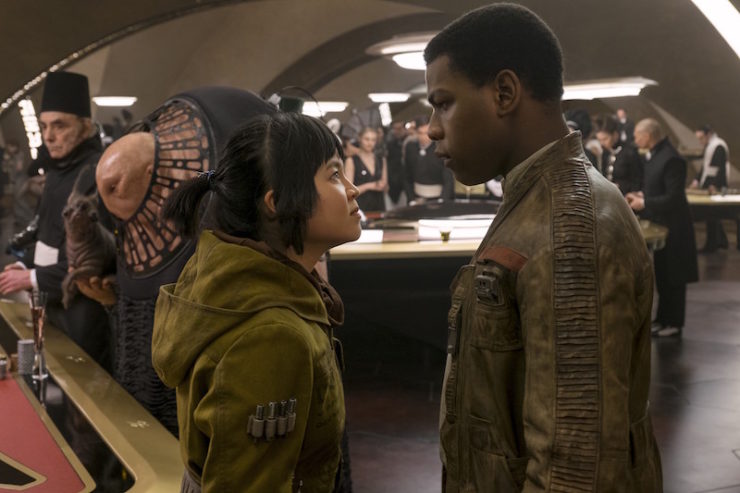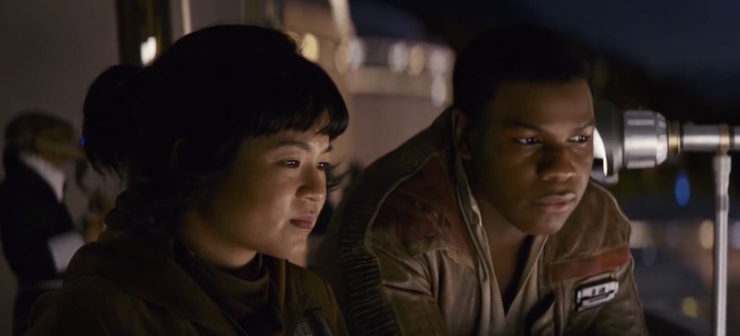Plenty of things about Rian Johnson’s The Last Jedi have been divisive, but few have been as derided as the Canto Bight sequence.
“The whole thing is just a disgracefully bad bit of storytelling.”
“…feels pointless and tacked on…”
Was it put there as a merchandising tool, a way to sell space pony plushies and several dozen more figurines? Does it fail to advance the story at all? Does it matter?
No, and no, and yes. Canto Bight is neither a fluffy diversion nor a tacked-on way to find something to do with Rose and Finn. It’s absolutely vital to the themes of The Last Jedi, and if you took it out, you’d lose more than just a few lines of dialogue about morality and wealth in the galaxy.
Canto Bight isn’t really about the rich people at all. It’s about the reality of life under a fascist First Order, and about unsung, unflashy work that needs to be done to fix the galaxy.
Spoilers for The Last Jedi follow.
One of the key themes of The Last Jedi is that we need heroes less than we need hope—and that the old narratives of heroes and heroics aren’t necessarily the most useful ones. Luke Skywalker doesn’t appear to defeat Kylo Ren, but to give the Resistance a shred of hope at survival. Kylo and Rey both hold out hope that they can change each other. Vice Admiral Holdo doesn’t care at all about how her choices look, but how they work—like Luke, she provides the Resistance with a moment of hope.
The little Force-sensitive kid at the end is the symbol of all that hope: a small boy from nowhere, who has nothing, gazing at the skies with determination on his face and a symbol on his finger.
But where did he get that hope?
From Rose and Finn.
Rose and Finn’s trip to Canto Bight is a failure from a mission standpoint: they don’t get the master codebreaker, but a thief who sells them out at the first sign of trouble. But while they’re there, they succeed at something we’ve not seen anyone else do: they seed a new place, a place full of wealth and privilege, with devotion to the Resistance. And they do it with kindness and hope.
There’s hope in Rose’s face when she reaches out to that stable boy, Resistance ring in hand. And there’s a huge reason it’s Rose who does this: she understands. She tells Finn what the First Order did to her mining-colony home, stripping it of resources and then testing it with weapons built with the planet’s own materials. She doesn’t have to say it outright, but it’s clear this is at least part of what led her to the Resistance: mistreatment by those in power.
So when, on a planet of wealthy pleasure-seekers, she sees a small, dirty-faced boy, she recognizes what it means to be that kid. Showing him the ring is a risk, but she knows he probably doesn’t have any loyalty to his masters (and not just because she saw said masters being cruel to both fathiers and children). She’s acting out of self-preservation, but also out of kindness. Even in a state of panic and danger, there’s no yelling, no shouting, no bossing. When she tells the boy they need his help, it’s a request, not a demand.
And that help makes a difference—for Rose and Finn, and for the fathiers. If it doesn’t solve everything—if Rose and Finn still need a lift offplanet; if the fathiers get rounded up again a few hours later—that’s also the point. Not everyone can fix the galaxy single-handed. Really, no one can. The little jobs are vital, too. Imperfect work is still work. And failure, like Yoda says, is a great teacher. Having tried, having made that choice, still matters.

What about Finn, though? At first I thought it weird that his role in this sequence was so small, but then I realized: he’s barely socialized. He’s barely out of Stormtrooper armor. He’s spent his whole life being ordered around by the First Order and its obsession with power through cruelty. It’s hugely valuable for him to be the observer, to see how people—both fancy and downtrodden—live in the galaxy, to see what conflict and class divisions have wrought, and to see exactly what it is the Resistance has to contend with.
Other arguments have been made for Canto Bight’s inclusion. David Sims at The Atlantic looks at the way the sequence illustrates the broader oppression in the galaxy—it sets up Rose’s last line, when she tells Finn they need to save what they love, not fight what they hate. The line is a little clunky, but if you consider it in the context of Canto Bight, it makes more sense: fight for the downtrodden stable kids, not against the bad guys.
Joanna Robinson’s great take at Vanity Fair focuses on the powerful representation of having two of the film’s characters of color go on a meaningful adventure of their own—and how this is a corner of the galaxy we haven’t seen before. “Neither rebels nor imperialists, the Canto Bight residents lend shades of gray to the universe in a way that’s explored in every corner of The Last Jedi,” Robinson writes.
In an interview with Syfy Wire, Star Wars concept designer Neal Scanlon said Canto Bight is his favorite creation of the new movie:
I think that’s Canto Bight, for two reasons, really. One is because there was no absolutes. And secondly, it’s really significant thing to The Last Jedi, that there’s a point in the film—and I think you’ll probably know what I mean when you see it—that we wave goodbye, a little, to the established past, and start to take those first independent steps. You know, the genre has got to turn, stand on its own two feet.
The genre has to stand on its own two feet—and so does the galaxy. The importance of Canto Bight isn’t fully clear until the very last scene of The Last Jedi, in which we return to that stable, and to the children who live there. Word of Luke’s actions in the climactic scenes has clearly spread: the kids have a little handmade Luke Skywalker figure, posed in front of their versions of walkers. The story being told is exciting—and, we know, not enough to change the world on its own. You need more than an exciting narrative; you need people, on the ground, doing the work. You need real examples of change created by ordinary people; you need change to look like something possible, not just for a select few. If the mythology of the Jedi was enough to motivate the galaxy to action, it wouldn’t be in the position it’s in.
But it’s a good story, and one many of us have told and retold, sitting on the ground, playing with Star Wars figurines, imagining ourselves princesses and warriors, generals and queens.
How many of us grew up to be those things?
What you can grow up to be, if not a crazy old wizard or a wise general, is a person who joins the fight. Who puts in the work, who runs the errands, who takes a moment to do something kind, even if it doesn’t necessarily matter to your mission. (Rose taking the saddle off the last fathier makes me tear up, every time.) The Last Jedi dismantles the idea that heroism is the only thing that changes the world, and leaves us with a little kid with hope in his heart—hope that was put there by two people who weren’t trying to be heroes, but were just doing their jobs.
Molly Templeton had to watch The Last Jedi twice before she fell in love with it, but she’s fully on board now.










